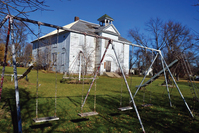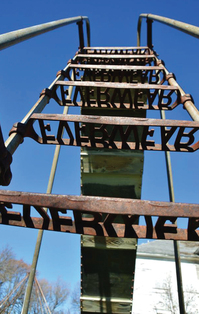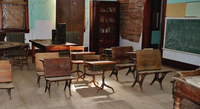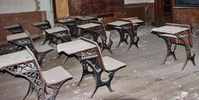As a child I always had a fascination with old buildings that has followed me through to adulthood, especially school houses.
I would pester my mom to tell me what it was like when she was a kid going to school. In her time, it was the traditional one room school house with one teacher, teaching grades kindergarten through eighth all together. They had electricity and a gas stove in the front of the room for heat. No running water, those families with the best drinking water would bring five-gallon cream cans filled each week to have available for the teacher and the kids. No running water also meant no indoor bathrooms, so they had out houses. The desks were wooden and lined up with usually the younger children up front and the older ones in the back for the seating arrangement. Most of the time she walked to school and there was no cutting through fields to save time as most of the fields held cattle and you were likely to get charged by one of them. They did have a swing set, merry-go-round and wooden teeter-totter, but mom would say they needed to be careful not to get a sliver in their bottom using that. They started their day saying the pledge of allegiance to the flag and at lunch time the Lord’s Prayer was said before eating.
Chores were a responsibility not only at home but at school as well. The floors were swept, chalkboards washed down and the erasers for the chalkboards were taken outside and beaten together to get the chalk out of them. In her formidable years to attend high school she would have to board with a family in town, who were complete strangers, as the family farm was thirty miles away. It was a different era and some of the circumstances she endured as she shared her stories was not to shock me or my siblings, but to teach us to be grateful for what we had and to appreciate life.
Each generation passes through childhood in their own way, with their own experiences.
My own memory of my grade school years consisted of a wooden two story, boxed school house in Lesterville, SD. We had split classes – two grade levels shared the same room with one teacher. The grades were kindergarten through sixth grade. Our play ground was across the road on an open field with no fencing. We carried our bases out with us to play kickball. We had a swing set, slide, merry-go-round, see-saw and a tether ball stand. We played games such as Red Rover, tag, duck-duck-goose, red light/green light and ring around the rosy just to name a few. We also said the pledge of allegiance to the flag before class started and had duties or chores. There was flag duty where a pair of kids put the flag on the flag pole outside of the school each morning and it was taken down at the end of the day. Usually on Friday the chalkboards were washed down and the chalk erasers had to be cleaned. This was my favorite and I couldn’t wait to be picked as it allowed you to go outside unsupervised. I once got bit in the hand by a garter snake that was hiding next to the foundation of the school to keep warm, my eraser fell under the lip of the board that sided the school house. I reached to pick it up and “snap”, it bit me. I’ll tell you, I wasn’t so eager after that to be picked to clean the erasers till I got a bit older. We had “paddling” in our school, which the principal did if you were bad enough to receive this. I did not experience this first hand, but my brother did, he was a bit naughty when he was a kid. Our parents were always informed if you “got out of line” at school. And you usually were disciplined again once you got home. This is quite the contrast to my mom’s memory as they had such a strong level of self-discipline, manners, and
respect, that the teacher rarely had to discipline a child for acting up.
The school house that I attended no longer exists and the one room school houses of my mom’s generation have almost all but disappeared.
The school house symbolized the singular pride of a community.
Ryan and I had the opportunity to explore this historic all wooden school house built in 1904 standing on the central edge of Hetland, SD. This is a very old community with a lot of history dating back to the late 1800’s. Hetland had every kind of business common to the Midwest. A hardware store, general store, a grocery store, drug store, hotel, bank, restaurants, barber shop, machine dealer, blacksmith, wagon shop, lumberyard, coal dealer, three grain elevators, a creamery, harness shop, a weekly newspaper, livery and feed stable. They also had a doctor, photographer, stone mason and several carpenters. By the 1900’s, Hetland continued to grow and this historic school house was built to accommodate the growing community. The school served to educate not only the local children but also the children from out laying agricultural areas. But like so many rural South Dakota schools, just like my mother’s school and my own grade school, it was closed by the early 1970’s. Unlike our schools this is on the National Register of historic places and continues to stand. Like most communities who lose their school, they also lose their businesses. Hetland was not immune to that as there were few homes or businesses remaining in this once thriving community.
We find on the school grounds the original playground equipment, consisting of a swing set, merry-go-round, see-saws, and slide. Once we entered the school house much of what we find is still intact and in their original places as if once those doors were closed for good almost fifty years ago that no one had touched a thing. The foundation was caving in and there was extensive water damage from the old roof so there were rooms where plaster from the walls had fallen off. The stairwell to the basement was almost gone as it had collapsed in several places. The first floor still held metal hooks down the hallway wall where the children would’ve hung their coats, rusted now and full of cobweb’s. The first classroom we entered had all windows boarded but half of one window exposed enough light revealing the original cast iron and wood desk lined up facing the front of the room where the teachers desk stood, and chalkboards held the ABC’s written across them. Books were displayed on several of the desks and a table at the back of the room. An old projector was also sitting outside of it’s case waiting to be turned on. In a second hallway at one end was the foyer or entryway to the front of the school and the bell tower was just above. The other end of the hallway held two bathrooms, clearly not in any kind of working condition and someone with a sense of humor had placed hand written signs laying across the broken toilet seats stating, “Out of Order”. A room towards the back of the school held a piano and there was not an empty spot of floor as more desk, chairs, boxes of books and other items were chaotically scattered throughout the room. Two large wooden staircases across from each other led to the second floor and we proceeded with our head lamps on, each ascending in opposite directions. The second-floor class rooms still held chalk boards on the walls and a few desks lined the rooms, but the water damage is even more apparent on the second level as the metal tiled ceilings showed massive rusting and holes and even more plaster from the walls laid in chunks almost every where you walked. The floor boards were soft to walk on and we both discussed to be extra careful where we stepped. I find what I believe to have been the principal’s office which was a very small room with the desk still present. A wooden ladder went up the wall and catches my eye, there is a hatch above it that led to the attic. I hear Ryan calling my name to come, “you have to see this”. So, my previous thought to climb the ladder and take a peak is now gone as I follow his voice in the dark to one of the most unusual things either of us had ever seen. On the second floor at the back of the school was a gym. An all-wood floor and a very narrow wooden balcony at the level of the basketball hoops, went around three of the four walls. There was a wooden ladder leading up to it that those attending a game would’ve had to climb and a single row of folding chairs would’ve been placed up there for the spectators to sit. We had both just stood in confusion looking around at this odd space. Why would you build a gym on the second floor? This question we asked each other over and over trying to make sense out of it. The floors were rotted in several spots and we decided it was time for our tour to end before one of us finds ourselves back on the first floor or even in the basement and not by way of the stairs.
Once outside and the warmth of the sun hits us on that early fall day we share the same hope for future generations. To see and to experience life in a simpler time where values, honor, and respect was the foundation of the school house. And the school house was the foundation of the community. It existed as a symbol of a community’s identity. Losing the school meant losing your town’s identity and eventually the communities very existence.






